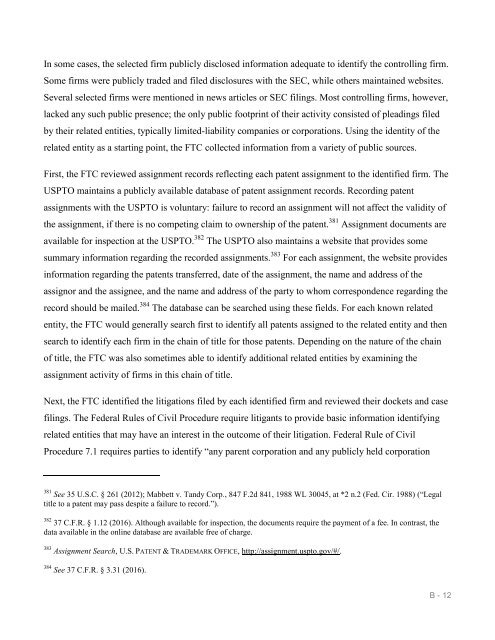You also want an ePaper? Increase the reach of your titles
YUMPU automatically turns print PDFs into web optimized ePapers that Google loves.
In some cases, the selected firm publicly disclosed information adequate to identify the controlling firm.<br />
Some firms were publicly traded and filed disclosures with the SEC, while others maintained websites.<br />
Several selected firms were mentioned in news articles or SEC filings. Most controlling firms, however,<br />
lacked any such public presence; the only public footprint of their activity consisted of pleadings filed<br />
by their related entities, typically limited-liability companies or corporations. Using the identity of the<br />
related entity as a starting point, the FTC collected information from a variety of public sources.<br />
First, the FTC reviewed assignment records reflecting each patent assignment to the identified firm. The<br />
USPTO maintains a publicly available database of patent assignment records. Recording patent<br />
assignments with the USPTO is voluntary: failure to record an assignment will not affect the validity of<br />
the assignment, if there is no competing claim to ownership of the patent. 381 Assignment documents are<br />
available for inspection at the USPTO. 382 The USPTO also maintains a website that provides some<br />
summary information regarding the recorded assignments. 383 For each assignment, the website provides<br />
information regarding the patents transferred, date of the assignment, the name and address of the<br />
assignor and the assignee, and the name and address of the party to whom correspondence regarding the<br />
record should be mailed. 384 The database can be searched using these fields. For each known related<br />
entity, the FTC would generally search first to identify all patents assigned to the related entity and then<br />
search to identify each firm in the chain of title for those patents. Depending on the nature of the chain<br />
of title, the FTC was also sometimes able to identify additional related entities by examining the<br />
assignment activity of firms in this chain of title.<br />
Next, the FTC identified the litigations filed by each identified firm and reviewed their dockets and case<br />
filings. The Federal Rules of Civil Procedure require litigants to provide basic information identifying<br />
related entities that may have an interest in the outcome of their litigation. Federal Rule of Civil<br />
Procedure 7.1 requires parties to identify “any parent corporation and any publicly held corporation<br />
381<br />
See 35 U.S.C. § 261 (2012); Mabbett v. Tandy Corp., 847 F.2d 841, 1988 WL 30045, at *2 n.2 (Fed. Cir. 1988) (“Legal<br />
title to a patent may pass despite a failure to record.”).<br />
382<br />
37 C.F.R. § 1.12 (2016). Although available for inspection, the documents require the payment of a fee. In contrast, the<br />
data available in the online database are available free of charge.<br />
383<br />
Assignment Search, U.S. PATENT & TRADEMARK OFFICE, http://assignment.uspto.gov/#/.<br />
384<br />
See 37 C.F.R. § 3.31 (2016).<br />
B - 12


